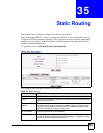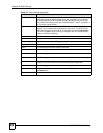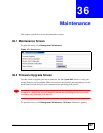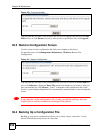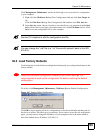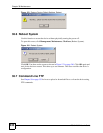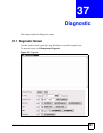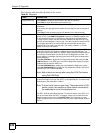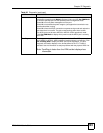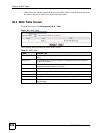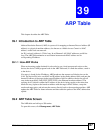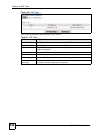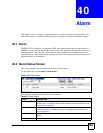
Chapter 37 Diagnostic
IES-612-51A User’s Guide
242
The following table describes the labels in this screen.
Table 80 Diagnostic
LABEL DESCRIPTION
Syslog/ Event Log Click Display to display a log of events in the multi-line text box.
Click Clear to empty the text box and reset the log.
IP Ping Type the IP address of a device that you want to ping in order to test a
connection.
In the field to the right specify the number of times that you want to ping the IP
address.
Click Ping to have the device ping the IP address (in the field to the left).
Loopback Test Select a port number from the Port drop-down list box and enter a VPI/VCI to
specify a PVC. Click OAM F5 Loopback to perform an OAMF5 loopback test
on the specified DSL port. An Operational, Administration and Maintenance
Function 5 test is used to test the connection between two DSL devices. First,
the DSL devices establish a virtual circuit. Then the local device sends an ATM
F5 cell to be returned by the remote DSL device (both DSL devices must
support ATM F5 in order to use this test). The results (“Passed” or “Failed”)
display in the multi-line text box.
LDM Test Select a port number from the Port drop-down list box and click Set LDM Port
to have the IES-612-51A perform line diagnostics on the specified port. The
ADSL port must be set to ADSL2 or ADSL2+ ADSL operational mode and have
a connection. It takes about one minute for the line diagnostics to finish. The
screen displays a message confirming upon which ADSL port line diagnostics
will be performed.
Click Get LDM Data to display the line diagnostics results after using the Set
LDM Port button on an ADSL port. Use the line diagnostics results to analyze
problems with the physical ADSL line.
Click Get LDM Data(raw) to display the unformatted line diagnostics results.
Click Get LDM Data(992.3) to display the line diagnostics results in the format
defined in the ITU-T G.992.3 standard.
Note: Wait at least one minute after using Set LDM Port before
using Get LDM Data.
SELT Select a port number from the Port drop-down list box and click Set SELT Port
to perform a Single End Loop Test (SELT) on the specified port. This test checks
the distance to the subscriber’s location.
Note: The port must have an open loop. There cannot be a DSL
device, phone, fax machine or other device connected to
the subscriber’s end of the telephone line.
The SELT takes at least fifteen seconds. To check the status of the SELT or to
look at the results when the SELT is complete, select a port number from the
Port drop-down list box and click Get SELT Data. The results tell you what
gauge of telephone wire is connected to the port and the approximate length of
the line.




